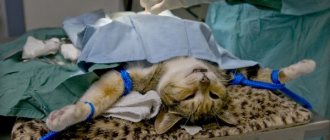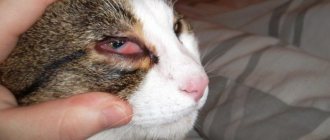(Be the first to vote!)
5589564
07/01/2021 owner reviews 1,
Lately, you've been noticing that your furry friend tends to slide his butt along the floor, which is an iconic dog behavior. Given the erratic nature of cats, you might at first think that your pet is just playing to kill time. However, upon closer inspection, cats often leave behind a brown discharge.
The liquids emit a rather unpleasant odor, leading you to believe that your pet has a serious problem. So, what should pet owners do if they are faced with the problem of brown discharge?
If you are concerned about your pet's health and want to know what is going on, this article is for you. Below, you'll find everything cat parents need to know about the problem of brown poop, from causes to treatment.
Generally speaking, the cat's anal area is vulnerable to a variety of diseases, so pet owners should pay attention to this area. As soon as you notice anything strange, it is extremely important to take your cat to a reputable veterinary clinic for a thorough examination.
- Causes of discharge
- Symptoms of anal sac diseases
- Diagnostics
- What to do
The cat's tail is wet - what should I do?
The cat is always the center of attention.
It is impossible not to pay attention to it. Yes, she often reminds herself of herself. If a cat's tail is wet, the owner will immediately notice it. This situation is not necessarily associated with something bad. First, you need to understand whether spilled oil or another substance is causing the problem. The cat could just get dirty. But if your tail is constantly wet, there may be several reasons.
Diagnosis and treatment
The appearance of bloody discharge under the tail, not associated with a physiological condition - estrus, requires contacting a qualified doctor for the necessary help. There are a large number of reasons for the appearance of blood in the tail area, and it is important to accurately determine the main one, which led to secondary symptoms.
Before going to the veterinary hospital, the pet owner can apply cold to the abdominal area and also give the pet complete rest. Cold helps relieve pain, narrow the lumen of blood vessels and stop bleeding for a short period.
Diagnosis of the pathological condition comes down to the following points:
- taking a general blood test from a vein;
- conducting a biochemical blood test to determine dysfunction of internal organs;
- analysis of urine and feces;
- ultrasonography;
- radiography.
The main task of the doctor is to stop the bleeding, find out the cause of the development and prescribe appropriate treatment for the underlying pathology. In case of uterine bleeding caused by injury or inflammation, surgical intervention is more often performed, the purpose of which is resection of the uterus (hysterotomy).
Doctors recommend sterilization with complete removal of the reproductive organs of animals that have reached sexual maturity and have no breeding value. Hysterotomy for bleeding from the uterus is also used for physiological abortion. This is due to the fact that applying ligatures to large blood vessels is always associated with risks. It is easier to remove the reproductive organ and appendages, thereby preventing the development of complications.
Diagnosed urolithiasis implies the use of special medications - antispasmodics and painkillers. Large stones formed in the genitourinary system require surgical intervention. After surgery and stone removal, it is important to follow a special diet.
Malignant neoplasms in the rectum or other parts of the large intestine are treated surgically, and are also supplemented by taking chemotherapy drugs that inhibit the growth of a malignant tumor.
Natural cause in cats
Your cat may have a wet tail due to the onset of the reproductive estrous cycle, popularly called estrus. A similar condition occurs in cats during sexual arousal. At this time, the animal’s body prepares for the process of mating, fertilization and pregnancy.
Estrus occurs in 4 stages:
- proestrus - takes 1-3 days, the cat attracts cats to her, but does not let them get close;
- estrus – lasts about 5 days, mating occurs;
- diestrus – 2-19 days, excitement subsides, most often pregnancy occurs;
- anestrus - sexual rest.
A discharge under the tail appears during the mating stage. At this time, the animal does not look like itself, purrs, and shows excessive tenderness. It often licks its genitals, from which a clear secretion is released. The first heat can begin at the age of 4 to 18 months, depending on the breed. What to do in this case?
There may be several options. The cat can be matched with a male, sterilized, or wait until everything goes away on its own. But for this you will have to be patient. Typically, estrus goes away within 5-15 days. If this does not happen, you should contact your veterinarian.
Please contact your operator for the cost of services not listed in the price list.
| Veterinary services | Cost, rub. |
| Vaccination of animals, vaccinations | |
| Routine cat vaccination | 550 |
| Routine dog vaccination | 650 |
| Vaccination of dogs at home | 900 |
| Vaccinations for puppies | 600-1000 |
| Vaccinations for kittens | 500-900 |
| Vaccination against rabies in dogs | 1250 |
| Veterinarian at home for vaccination | 400 |
| Animal surgery (surgery for dogs, surgery for cats) | |
| Removal of papillomas | 500 |
| Removal of subcutaneous tumor | 600-1500 |
| Cat sterilization | 1900 |
| Sterilizing a cat at home | 2250 |
| Castration of cats | 1450 |
| Castration of cats at home | 1700 |
| Dog sterilization | 2700 |
| Dog castration | 2200 |
| Sterilization of cats laparoscopy | 2900 |
| Castration of a male dog | 2700 |
| Sterilization of dogs laparoscopy | 3200 |
| Tail fracture in a dog, treatment | 900 |
| Fractures in dogs | 1100 |
| Fracture/dislocation in a dog | 900 |
| Fracture/dislocation in a cat | 900 |
| Pinched toes in dogs | 1300 |
| Amputation of vestigial digits in dogs | 1150 |
| Animal therapy | |
| Treatment of wounds and surgical sutures | 250-350 |
| Removing stitches for a dog or cat | 200-350 |
| Injections for a cat | 300-400 |
| Injections for a dog | 400-500 |
| Probing the dog's esophagus | 1380 |
| Gastric lavage in a dog | 1550 |
| Euthanasia of animals | |
| Put the dog to sleep | 2400 |
| Putting a dog to sleep at home | 2600 |
| Put the cat to sleep | 1600 |
| Euthanasia of cats | 1600 |
| Euthanasia of a cat at home | 1800 |
| Animal cremation | |
| General pet cremation | 1500-2500 |
| Individual animal cremation | 3500 |
| Cremation of dogs (up to 10 kg) | 3000 |
| Cremation of dogs (from 10 to 20 kg) | 5000 |
| Cremation of a dog over 20 kg | negotiable |
| Cremation of cats | 1550 |
| Animal diseases and their treatment | |
| Inflammation of the ear in a dog, otitis media | 1150 |
| Toxoplasmosis in a dog | 1450 |
| Piroplasmosis in dogs treatment | 1850 |
| Dermatitis in a dog | 950 |
| Rhinitis in dogs treatment | 970 |
| Stomatitis in a dog | 970 |
| Treatment for styes in dogs | 980 |
| Urolithiasis in cats | 1850 |
| Heart failure in a cat/dog | 1600-1900 |
| Feline panleukopenia | 2140 |
| Toxoplasmosis | 950 |
| Distemper in a dog | 950 |
| Staphylococcus in a dog | 850 |
| Piroplasmosis in a dog/cat | 1800 |
| Ringworm in cats and dogs | 100-800 |
| Worms in a cat | 700-1200 |
| Veterinarian services | |
| Calling a veterinarian to your home | 400 |
| Vet visit at night | 600 |
| Veterinarian ophthalmologist reception in veterinary clinic | 1200 |
| Doctor ratologist reception in veterinary clinic | 1250 |
| Turtle doctor (herpetologist) | 1250 |
| Treatment of ferrets | 1050 |
| Treatment of rats | 1050 |
| Treatment of rodents | 1100 |
| Treatment of hamsters | 1100 |
| Reptile doctor | 1600 |
| Treatment of mice | 1100 |
| Animal grooming. grooming salon | |
| Calling a veterinarian-groomer to your home | 1200 |
| Dog grooming | 1300 |
| Cat grooming | 980 |
| Washing and drying dogs | 630 |
| Model dog haircut | 1560 |
| Hygienic cat grooming | 1050 |
| Removing tangles | 690 |
| Trimming cat's claws | 590 |
| Trimming dog's nails | 790 |
| Zoohotel | |
| Dog foster care | 380 |
| Hotel for cats | 270 |
| Hotel for dogs (for stays longer than 7 days) | 350 |
| Dog foster care (vip conditions) | 800 |
| Overexposure of large breed dogs | from 800 |
| Tests for animals | |
| Adenovirus/canine hepatitis | 600 |
| Blood test for infections (PCR) | 750-1900 |
| Canine herpes virus | 630 |
| Borelliosis Lyme disease | 650 |
| Feline calicivirus | 630 |
| Brucellosis | 650 |
| Epstein-Barr virus | 650 |
| Leptospirosis | 650 |
| Mycoplasmosis | 650 |
| Canine piroplasmosis | 660 |
| Panleukopenia | 650 |
| Parvovirus enteritis | 650 |
| Carnivore plague | 550 |
| Diagnostics for animals | |
| Radiography 1 projection | 1000 |
| X-ray 2 projections | 1700 |
| Echokg for animals | 2400 |
| ECG (electrocardiography) | 3000 |
| Ultrasound examination of all organs | 2500 |
| Ultrasound for cats (one organ) | 1450 |
| Ultrasound for dogs (one organ) | 1600 |
| Dentistry for animals | |
| Removing tartar from a cat | 2160 |
| Removing tartar from a dog | 2380 |
| Cat teeth extraction | 480 |
| Dog tooth extraction | 690 |
| Assistance in childbirth for animals | |
| Conservative obstetrics | 1000 |
| Cat birth assistance in adoption | 1200 |
| Examination of a cat before birth | 900 |
| Childbirth in a cat, help with complications | 1500 |
| Childbirth in a dog, help from a veterinarian | 1920 |
| Caesarean section for a cat | 3000 |
| Caesarean section for a dog | 5000 |
Pyometra
If estrus does not stop for a long time, a uterine infection may be suspected in the cat. This is a serious disease that threatens the life of the animal. It is impossible to do without veterinary control.
Pyometra occurs due to hormonal changes that occur in the genital tract of a mature cat. The cause of the disease is often pregnancy that does not occur within several heat cycles. During estrus, the cervix is slightly dilated. Because of this, bacteria enter the reproductive organ. If the walls of the uterus are thickened due to unsuccessful attempts to get pregnant, bacteria begin to develop in them.
The infection manifests itself as purulent vaginal discharge. They can be noticeable under the tail, on the fur, on the bed.
If the disease is confirmed, the specialist will recommend removal of the uterus and appendages.
Anal gland problem
Cats quite often have problems associated with the excretory system . If your cat has a wound under his tail that is not related to injury, you should consult a veterinarian. It can be caused by a blockage of the sebaceous glands near the anus.
The disease is called inflammation of the paraanal glands. The secretion from the glands spreads throughout the body and leads to inflammation of neighboring tissues. An abscess appears. Left untreated, it can make it difficult for your cat to go to the toilet. Then blood poisoning occurs.
When the glands under the tail become inflamed, you may notice a discharge with a strong odor, an ulcer, a fistula, or a lump.
The problem can be treated with medications and gland cleaning. To prevent it, it is important to balance the cat’s diet and monitor the condition of the sebaceous glands. Then it won’t be wet under your tail either.
How to express a cat's anal gland
If you see that your cat is licking her anal area a lot and is unable to release anal discharge properly, you may need to evaluate the gland yourself. However, although you may need to manually express the glands, it is best to go to the vet the first time so they can both show you how to do it correctly and make sure your cat is exposed to best practices first. This will help you express your cat's anal glands more easily.
Ideally, you will want someone to help hold the cat while her anal gland expresses. This is because it can be a very uncomfortable and even painful procedure. Once you have someone restraining the cat, you should lift the tail and look for the glands. For this procedure, it is better to wear rubber or latex gloves. Using your thumb and forefinger, grasp the individual gland and squeeze it towards the anus, where fluid usually comes out. You may want to leave the newspaper as the smell of the secretion can be quite unpleasant. The anal gland secretion should be brown, so if it is not, you should talk to your veterinarian.
Why does my cat leak fluid from her anus?
If the owner notices discharge from the cat's anus, which looks like pus and has an unpleasant odor, there is no need to hesitate to visit the doctor. Often the cause of this pathological condition is inflammation of the paraanal glands located in the anus. However, the reasons for the appearance of pathological fluid under the tail may be different; one of the most dangerous is a malignant tumor of the anus. Therefore, for treatment to be effective, it is necessary to determine an accurate diagnosis and eliminate the original source of the problem.
Abscess in a cat's anal gland
An infection may just be the beginning of the problem if our cat has problems with your anal glands . If our cat has fluid coming out of his anus, as described in the previous section, we should take a look at the gland itself. When the gland becomes red, then purple and enlarged, we may suspect that an abscess has formed. In these cases, devastation alone will not solve the problem. An anal gland abscess can grow so large that it breaks the skin and becomes a fistula, which can be very uncomfortable and painful for the cat.
The veterinarian will clean the area and prescribe antibiotics, but surgery . Although some people may fear that anal abscess in cats may be cancerous, it is important to remember that this is unlikely as carcinoma of the saccule accounts for[s]0.5% of all feline skin neoplasms .
Why does my cat leak fluid from her anus?
The main reason that provokes discharge from the anus in a cat is inflammation of the paraanal glands.
It has been noted that long-haired pets are more susceptible to this disease than their short-haired relatives. The inflamed area on the butt gradually increases in size, and pathological exudate accumulates inside the gland. If therapy is not started in a timely manner, a bacterial infection occurs, which threatens suppuration and the development of sepsis.
Types and symptoms
The nature of the discharge differs depending on the type of disease and the stage of its development. At the initial stage, due to inflammation localized in the anal area, the natural outflow of secretions from the glands is disrupted. When a bacterial infection occurs, yellow or white discharge that the cat leaves on the floor, carpet, and furniture is disturbing. At the time of defecation, the animal’s anus hurts, so the cat tries to visit the litter box less often, constantly screams, and worries. Other signs of the initial stage:
- extensive loss of fur;
- formation of ulcers and rashes under the tail;
- increased body temperature;
- fever.
The longer the disease progresses, the richer the color of the discharge becomes. Blood from the cat's anus indicates that the disease is advanced, and the animal needs urgent medical attention. Otherwise, the risk of developing an abscess increases, which poses a serious threat not only to the health, but also to the life of your four-legged friend.
Treatment of the inflammatory process
Treatment of inflamed paraanal glands should only occur in a veterinary clinic under the supervision of a physician after a thorough examination and assessment of the severity of the lesion.
Therapy involves cleaning, rinsing or removing the affected glands.
Cleaning
At the initial stage of the disease, cats undergo cleaning of the paraanal glands. Depending on the consistency of the accumulated secretion, this procedure can be carried out in the clinic or at home by a visiting veterinarian or an experienced breeder. In any case, cleaning brings discomfort to cats, so it will be more convenient to do it together.
Before cleaning the glands from accumulated secretions, it is necessary to palpate them to determine the consistency of the contents.
If the secretion is liquid, you can clean it yourself using an external method. The animal should be secured, the inflamed glands should be covered with a napkin and their contents should be carefully squeezed out - to do this, you need to squeeze the sides of the anus with two fingers and squeeze.
If a liquid with a very pungent and unpleasant odor appears, the procedure can be considered successful. At the end of the manipulation, the anal area must be treated with Chlorhexidine.
If the contents of the glands are dense, the procedure should only be performed by a doctor, since the cat will need internal cleaning, which is called the rectal debridement method. In such a situation, the index finger is inserted into the animal’s rectum, the outside is felt with the thumb and the contents are gently squeezed out. At the end of the procedure, the anus is treated with an antiseptic solution, and ¼ of an anti-inflammatory suppository is inserted inside.
Important! It is forbidden to clean cats that do not have inflammation of the paraanal glands, since such intervention can lead to disruption of their normal functioning.
Washing
Washing should be carried out exclusively by a veterinarian in a clinic setting. This procedure is indicated in the most severe cases, when a fistula or abscess has formed, and other methods do not bring results.
First, the cat's anal glands are cleaned mechanically. Then, under local anesthesia, a solution of potassium permanganate, Chlorhexidine or another antiseptic is injected into the anus using a catheter or syringe without a needle.
The procedure must be repeated several times until the flowing liquid becomes clear. This will indicate that there is no thick secretion or pus left in the paraanal glands. Next, the cat is given rectal anti-inflammatory suppositories, and the outside of the anus is lubricated with antiseptic ointment.
Important! Depending on the severity of the disease, the animal may also be prescribed antibiotic therapy.
Removal
In the most severe cases, when it is no longer possible to clean and washing does not bring results, veterinarians remove the paraanal glands from cats. Doctors also recommend this operation for pets who constantly suffer from blocked ducts.
Regular cleaning is a significant stress for cats, so removing the anal glands will make life easier for both owners and their pets.
The removal operation is performed under general anesthesia. The doctor makes 2 small incisions in the area where the anal glands are located, removes them along with the ducts and applies sutures. In the future, the owners need to treat the wound with a healing preparation, and also give the cat vitamins for speedy skin regeneration and antibiotics (if indicated, for 5–7 days).
Important! Owners need to ensure that the cat does not become constipated until the stitches heal. Otherwise, they may separate.
Diagnostics
If a cat has light, cloudy or bloody discharge from the anus, the anus itself is swollen and hurts when pressed, it is necessary to urgently take the animal to a veterinary clinic. An experienced veterinarian will be able to establish an accurate diagnosis during the initial examination. However, with other diseases, you may notice that ichor or blood is dripping from the anus. Therefore, additional diagnostic methods are necessarily prescribed:
- general blood and urine analysis;
- biochemistry;
- microscopic examination of feces;
- radiography;
- Ultrasound of organs located in the abdominal cavity.
Return to contents
What treatment is prescribed?
If a cat has a red bottom and is bleeding due to inflammation of the paraanal glands, complex treatment is necessary, which consists of the following procedures:
The drug will help heal existing skin damage under your pet’s tail.
- Mechanical cleaning. There is external and internal. In the first case, you can clean the anus yourself by pressing on the inflamed gland and releasing the exudate accumulated inside. If external cleaning is not possible, internal cleaning is performed, but this is done by a doctor on an outpatient basis.
- Disinfection. The next step is to treat the anus with an antiseptic that will help destroy the bacterial infection and prevent inflammation. It is recommended to drip Miramistin or Chlorhexidine solution onto inflammatory areas.
- Applying ointment. Levomekol or streptocidal ointment will help speed up the healing of wounds. It is recommended to apply the product first on a napkin or gauze, and then apply everything to the sore spot. Continue therapy until the damage heals and the red, inflamed spots disappear.
- Use of antibiotics. Prevents the formation of an abscess and the spread of inflammatory complications to surrounding tissues. It is recommended to use the drugs “Penicillin” or “Gentamicin”, which are best administered intramuscularly or subcutaneously.
Taking a vitamin complex will strengthen the weakened body of the fluffy.
During therapy, the animal's immunity can be severely damaged. In order to normalize the body’s protective functions and quickly recover from an illness, vitamin and mineral complexes are prescribed. If a relapse is observed and the cat is leaking from the rear hole again, repeated cleaning is carried out urgently. Often complications and relapses of the disease occur in sterilized or neutered cats.
Treatment of anal discharge
But many pet owners do not want to resort to the services of veterinary clinics. Of course, if the owner is absolutely confident in his abilities and is fully aware of the situation that is happening to his cat, more independent treatment is allowed. However, beginners should listen to the opinion of doctors so as not to put their cat at risk.
Sometimes ridding a cat of discharge from the anus is not so easy . If the abundance of secretion does not decrease and lasts for several days, an examination should be performed. Here you must thoroughly wash and disinfect your hands. Next, you need to squeeze the area adjacent to the animal’s sphincter with two fingers. If at the same time a thick and viscous secretion occurs, it makes sense to think about the presence of certain disorders in the animal’s body.
To avoid worsening the situation, a whole range of measures should be taken to help correct the cat’s condition. Initially, you should arm yourself with special medical gloves. After smearing your finger with Vaseline, you need to insert it into the source of the cat’s discharge.
Carrying out manipulations according to the instructions will lead to an improvement in the pet’s condition within 2-3 days.
However, this procedure cannot be performed without special skills and a full understanding of what is happening. The best thing is to trust the professionals at the veterinary clinic, who will professionally take care of the animal’s health.
If the disease is advanced, doctors can prescribe complex treatment for the discharge. Both procedures and medications will be used here. Antibiotics are especially often recommended. If a cat is bleeding from the anus, this may be a reason for surgery . However, this is an extreme measure that is carried out quite rarely. Often less radical methods of treatment are sufficient, even if it involves bleeding.
After the cat’s condition improves, you should consult a doctor about preventing discharge. This will avoid relapses and improve the cat’s overall condition. Only compliance with the doctor's instructions can prevent the worsening of chronic diseases and the recurrence of inflammatory processes. He can give advice related to:
- cat care;
- food;
- routine examinations of the animal.
It's a shame when your beloved pet gets sick. Especially when the kitten has discharge from his butt. However, the main goal, in this case, should be a directed and productive fight against the disease.
Timely measures can not only alleviate the cat’s condition, but also quickly save it from a dangerous disease.
Therefore, most owners try to make every effort to create favorable conditions for their beloved animal to recover.
Preventive measures
To ensure that the disease no longer bothers your pet, it is necessary to identify the original source of the problem and try to eliminate it. Often inflammation of the paraanal glands occurs due to improperly selected cat nutrition. In such a situation, it is better to contact a veterinarian who will help you create a balanced diet rich in essential vitamins, nutrients and other vital elements.
In addition, it is important to monitor the body weight of your four-legged friend and encourage him to spend time actively. You should not skip scheduled preventative visits to the doctor, during which you should describe in detail how your pet is behaving and whether it has any suspicious discharge. If relapses occur frequently in cats, to prevent complications, the veterinarian will advise removing the paraanal glands, which will save the pet from suffering.
Source
Cat, cat and kittens
In our country, many people have cats at home, but very few know about the most common cat diseases and their symptoms. This article will tell you about some common diseases of cats, which will allow you to better protect the health of your pet. Because if you know the symptoms, you can quickly respond to your cat’s condition, and your pet will receive the necessary treatment and recover much faster. This will not only reduce the severity of the disease, but also relieve the cat or kitten from unnecessary stress caused by poor health. That's why it's so important to get advance information about feline diseases, their symptoms, and the necessary steps to take to protect your beloved pet.
You surround your pet with love and care, however, this is only part of your responsibilities as a pet owner. It is equally important to ensure optimal nutrition and proper treatment in case of illness.
Some cat diseases require the intervention of a qualified veterinarian, but there are also many cases where you do not need such assistance. Once you recognize the early symptoms of the disease, simple steps are often enough to restore your cat's strength and health. And, of course, it is important to take certain precautions to protect your cat from diseases for as long as possible.
Now let's take a quick look at some of the most common cat diseases and their main symptoms.
Urinary tract infection
Urinary tract infection is a very common condition in cats. Typical symptoms are that the cat meows pitifully (cries) when trying to go to the toilet to pee. In rare cases, blood may be found in the urine. You may also notice that your cat frequently tries to urinate to no avail. This infection causes severe pain in cats and they may begin to urinate all over the house. The reason is simple - the cat thinks that the pain is associated with the place where she goes to the toilet (with the tray) and tries to change it, and not with internal problems.
UTIs in cats can come in different forms. When the disease is mild, the owners often do not even suspect that it exists at all. Recovery also goes unnoticed by them. But there are also more severe cases when the help of a veterinarian is required. In most cases, veterinarians use antibiotics to treat this disease, which almost always help cope with the infection. In rare cases, if the disease is not treated properly, it can lead to serious complications, the infection can spread to the kidneys, which is very painful for cats. Blockage of the urinary tract may occur, which prevents normal urination and threatens the pet’s life. This is why it is important to contact your veterinarian if you notice any of the above symptoms in your cat.
Upper respiratory tract infection
Upper respiratory tract infections in cats and kittens are very similar to the common cold in humans. Remember that these infections are airborne and can easily spread to your other pets through contact with a sick cat or through contact with objects or food (for example, cats eating from the same bowl).
Typical symptoms:
- Fever;
- Runny nose;
- Sneezing;
- Bloodshot eyes;
- Decreased appetite.
Plague
The next common disease is called feline distemper, also known as panleukopenia. This disease is caused by a virus that spreads through contaminated water, food, and litter trays. The source of infection and the spreader of the disease are sick or recovered cats, which release viral particles into the environment through feces and vomit. A sick animal becomes lethargic and refuses to eat and drink. Distemper also causes severe diarrhea and vomiting. If treatment is not started early, this disease often leads to the death of your pet. More information about distemper can be found here “ Distemper in cats ”.
Peritonitis
Feline infectious peritonitis is also caused by a virus and is usually spread in homes with two or more cats. The most common symptom is constipation. Other symptoms include weight loss, loss of appetite, and fever. Feline infectious peritonitis is one of the most serious diseases of cats and is almost always fatal.
Diabetes
Diabetes is also one of the common diseases in cats. This disease occurs when a cat's body is unable to produce enough insulin to maintain normal blood sugar levels. With diabetes, cats drink a lot and often and, accordingly, urinate often. Your cat may also have an increased appetite. Treatment consists of dietary changes and regular insulin injections.
Worms
Cats very often become infected with worms. The most common types of worms are:
- Roundworms (nematodes): Cats become infected with these worms by eating infected lizards, rodents or birds. One of the most dangerous parasites among nematodes is hookworm. Hookworms are very small in size, their mouth is like a hook, with which they burrow into the intestinal walls and suck blood. These worms can cause anemia, black (bloody) diarrhea and, in more serious cases, even death in kittens. There is also a type of roundworm called heartworm, but fortunately it is most common in the United States and is also found in South America, southern Europe, South Asia, Australia and Japan.
- Tapeworms: Cats become infected by eating an intermediate host, such as infected fleas or rodents. Infection causes vomiting and weight loss. In a sick cat, you may see segments of the worm that resemble grains of rice or cucumber seeds in the fur around the anus.
The question is how to understand that a cat has worms. Here are the most typical symptoms:
- Vomit.
- Loss of appetite.
- Diarrhea (diarrhea), sometimes containing blood.
- The cat's coat may be in poor condition.
- Anemia (anemia). This is easy to check - a cat or kitten with anemia will have pale gums.
- Swollen round belly;
- Segments of worms in the anal area. These pieces of worm look like small grains of rice or sesame seeds.
- The cat is losing weight.
Worms can be easily gotten rid of with proper treatment. If left untreated, these parasites can cause serious health problems.
More information about worms in cats can be found here “ Worms in cats ”.
Vomit
Typical causes of vomiting are:
- Ingestion of a toxic (poisonous) substance into the body;
- Peptic ulcer;
- Mild indigestion;
- Getting rid of hairballs;
- Vomiting can also occur if the cat gets seasick on a trip.
If the cat has been vomiting, it is not recommended to feed it for approximately eight hours (unless the vomiting was associated with getting rid of hairballs - this is normal and nothing to worry about). Water can be given after two hours if this does not provoke new attacks of vomiting. Give water every hour if your cat is thirsty. When resuming feeding, you should offer the cat a small amount of soft food, gradually increasing its amount to normal. If vomiting is persistent, persistent, or accompanied by other symptoms, take your cat to the veterinarian.
More information about vomiting in cats can be found here " Cat Vomiting ".
Diarrhea
Here are some common causes of diarrhea in a cat:
- Worms or intestinal parasites;
- Bacterial or viral infection;
- Medications: Diarrhea may be a side effect of taking medications to treat another illness.
- Poor nutrition;
- Too much food;
- Sudden changes in a cat's diet.
Diarrhea usually does not last more than 24 hours. Experts recommend not feeding the cat for the next 24 hours. However, this only applies to adult animals. Don't starve your kitten, as he may experience hypoglycemia (dizziness and lethargy due to low blood sugar). Water should be given in small quantities every few hours.
More information about diarrhea in cats can be found here: Diarrhea in cats .
This, of course, is not a complete list of cat diseases, but just a brief overview of several of the most common ones. These and other cat diseases are discussed in more detail in the Veterinary of this website.
Some of these diseases cause anxiety and concern for owners, but the more informed you are, the faster you can recognize the early symptoms of the disease and begin treatment promptly.
What kind of discharge from the anus (anus) do cats have and why?
Blood and mucus sometimes come out of a cat's anus along with feces. Mucus formation often occurs when there is an imbalance of nutrients in your pet's daily diet. Mucous masses are secreted from the anus in diseases of the digestive system, inflammation of the mucous membrane of the stomach and intestines. Worm infestations also lead to the appearance of a similar symptom.
Blood in a cat's feces may be a sign of a viral disease or bleeding in the intestines. Lack of water sometimes causes constipation in animals. Hard feces injure the walls of the rectum, leading to the appearance of drops of blood during defecation.
Consequences of worm infection
In the absence of regular antiparasitic treatment, worms may appear in pets, including cats. Not only animals with access to the outdoors are susceptible to infection. Cats that do not leave the apartment are also not immune from parasites. They enter the body of cats when they eat raw meat or fish products, or when interacting with other pets. In addition, a person can bring worm eggs home on his shoes.
Parasites most often settle in the intestines of animals. They multiply quickly and in the process of life damage the intestinal walls. You can notice signs of infestation by the presence of mucous fluid in your pet’s feces. In severe cases, bloody spots appear in the stool. Sometimes the mucous mass from the anus flows randomly, regardless of the exit of feces.
Worm damage is usually accompanied by weight loss with a good appetite and an enlarged abdomen, which is especially noticeable in kittens. For treatment in such cases, the veterinarian prescribes antiparasitic drugs. The doctor chooses the dosage and type of medication taking into account the weight and age of the animal. In the future, it is necessary to carry out regular prevention to prevent re-infection.
Constipation in an animal
Some cats suffer from constipation. In some cases, constipation indicates digestive problems, but usually this problem occurs in animals whose diet is based on dry food. With this type of diet, you need to ensure that your pet receives a sufficient amount of fluid. Otherwise, the feces become too hard and do not move well through the intestines, compromising the integrity of the mucous membranes.
With constipation, bowel movements are difficult, so droplets of blood often appear in the stool. The owner can understand that the pet is constipated by other signs:
- meowing before defecation;
- trembling during bowel movements;
- absence of feces for more than 3 days;
- hard and small feces.
To find out the cause of constipation, it is better to consult a veterinarian. If he does not reveal any abnormalities in the animal, then the correct selection of diet will help solve the problem. As an urgent aid, you can use an enema with chamomile decoction. Adding a few drops of vegetable oil to the food will also help your cat move his bowels.
General information
Let’s immediately deal with one important nuance. There is discharge during pregnancy, and there is immediate prenatal discharge. If your cat has any “leaking” from the external genitalia, and there is still a month left before giving birth, immediately take your pet to the veterinarian. Discharge during such a period is an unambiguous pathology, indicating the presence of inflammatory processes in the organs of the cat’s reproductive system.
Discharge that appears shortly before birth does not pose any danger. It is very likely that your pet is simply losing a mucus plug from the cervix. This can happen about three days before giving birth. If mucous discharge appears much earlier than this period, you should contact a veterinarian. Early removal of the plug does not bode well for either the cat or her offspring.
Mucus plug, what is it and what is it for?
Any animal lover who has experienced childbirth in their pets at least once probably knows about the existence of the cervix. This is the tubular part of the organ, the function of which can be compared with the intestinal sphincters, for example. In the normal state (when the cat is not pregnant), the cervix is always tightly closed due to contraction of muscle tissue. This reliably prevents pathogenic and conditionally pathogenic microflora from entering the organ cavity.
The uterus must always and in all cases remain sterile! Everything else is a deviation from the norm.
At the time of birth, a certain number of microbes may enter the organ cavity, but, as a rule, the body is able to cope with them on its own.
True, there is one nuance. During pregnancy, the cervix is no longer closed so tightly. This is due to the fact that subsequently the organ will still have to relax, since otherwise the cat will not be able to give birth. It is at this time that the mucous plug acquires special significance: it serves as a “plug” that does not allow dirt and microorganisms into the organ cavity.
Cork is impenetrable to air and other environmental factors. Damage to it during pregnancy is always fraught with a number of extremely unpleasant consequences. In cases where the integrity of the “plug” is broken in the last three to five days before birth (brown mucus), nothing bad will happen. This is a completely physiological phenomenon, and it poses no danger either to the cat itself or to its offspring.
But in situations where the plug is damaged long before childbirth, this does not bode well: pathogenic and conditionally pathogenic microflora, dirt and other negative environmental factors enter the cavity of the pregnant uterus. All this leads to the development of severe inflammatory processes.
Signs of mucous plug coming off before childbirth
If the cat is fairly clean and regularly licks the genital area (and right before giving birth, she does this all the time), then you may not notice anything. But the classic signs of a mucous plug coming off is the appearance of mucous discharge from the external genitalia . Normally they are pink, but may have a reddish-pinkish or even brown color. Let us emphasize once again that this is a completely normal phenomenon, and it does not pose any danger to the health and life of the animal.
But with normal prenatal discharge, the animal’s behavior should also remain normal. Since the animal senses the approaching birth, it becomes restless and constantly runs around the house in search of the most suitable place for kittens.
If something is wrong, the cat may meow “hysterically,” avoid contact with the owner, and react inadequately to attempts to palpate its stomach. If such signs appear, you should immediately contact a veterinarian.
Discharge in cats from the loop (vagina)
In females, fluid under the tail can flow not only from the glands or anus, but also from the genitals. In some cases, mucus in the cat's loop area is a natural sign of estrus, and fluid may also be released from the uterus after birth. However, often bloody or purulent masses flowing from the loop indicate the development of a serious pathology of the reproductive system.
Physiologically determined secretion
Vaginal secretion is considered normal if it appears in a cat during estrus, immediately before the onset of labor, or after the kittens are born. When in heat, they have a slimy consistency. The discharge from the loop is transparent and homogeneous, but the presence of small spots of blood in it is also considered normal. The physiological liquid substance during estrus has no odor, so in most cases it goes unnoticed by the owners and ceases to be released after a few days.
Before giving birth, a white or yellow mass comes out of the vagina. There may also be a small amount of blood present. After the start of contractions, the cat's amniotic fluid is greenish in color. After childbirth, it is important to observe the color of the mucous secretion coming out of the genital tract. If it has a bloody tint, then it is necessary to show your pet to a veterinarian to prevent the development of complications.
Purulent discharge and its cause
When a cloudy mass comes out of a pet’s loop, this always indicates the development of pathology. Purulent clots are released from the vagina with the following disorders:
- injuries of the genital organs, ureter;
- pyometra;
- infectious lesions of the reproductive system;
- urological diseases.
Bloody issues
Brown or reddish vaginal discharge from a cat that is not pregnant, is not about to give birth, and is not looking for a mating partner is also not normal. This phenomenon indicates an inflammatory process in the internal genital organs and other pathologies. The cat must be taken to a veterinary clinic for examination. The sooner the cause of the disorder is identified, the greater the animal’s chances for a quick recovery.
Bloody discharge often appears in diseases caused by hormonal imbalance, coagulation disorders, endometritis, and inflammation in the uterine cavity. In addition, brown and red mucous clots are observed in cats with neoplasms in the vagina, vaginitis. Since cats are very clean, owners may not notice the discharge until the disease reaches a severe stage, so it is important to carefully monitor their pets and pay attention to changes in their behavior, mood, appetite, and habits.
What's under the tail of a cat and a cat, or a little anatomy
Bloody, mucous, or purulent masses found under the cat's tail may be discharged from the genitals, anus, or anal glands. The anus is part of the rectum, so the flow of blood or purulent mass from it indicates problems in the digestive tract, inflammation of the intestinal mucosa, and helminthic infestation.
The paraanal glands are small formations located on the left and right of the anus. They produce a thick secretion that helps animals mark their territory. If the contents of these glands stagnate and do not come out for a long time, an inflammatory process develops.
In addition, cats have external genitalia near the anus. Discharge from the loop is a manifestation of estrus, a sign of diseases of the reproductive and urinary systems. Sometimes blood appears in the loop area during pregnancy, which can also indicate abnormalities and the threat of miscarriage.
Unexplained fluid under the tail is a symptom of inflammation of the paraanal glands
Clots with a specific odor that appear in a cat regardless of bowel movements may indicate inflammation of the anal glands. Normally, the secretion leaves them unnoticed by others. However, if bacteria from the intestines enter the glands located near the anus, inflammation begins in them. The pet experiences discomfort, constantly licks itself in the anus, and tries to rub it on the carpets or floor. Pus accumulates in the glands, they increase in size, and swelling may be noticeable on one or both sides of the anus.
When is it necessary to consult a veterinarian?
Blood in the feces, as well as other brown, yellowish, green or purulent discharge, in most cases indicates a disorder in the animal’s body. Self-treatment can only worsen the situation. Without knowing the exact diagnosis, you should not give your pet any medications. You should consult your veterinarian if you have the following symptoms:
- the presence of unusual discharge in the stool;
- pronounced unpleasant odor and mucus or pus under the tail;
- feces that are black or have blood in them;
- bowel disturbances, accompanied by refusal to eat and drink, vomiting;
- temperature increase;
- lack of stool for three days;
- change in stool if ingestion of a toxic substance is suspected.
Source
Prevention is the key to health!
Thus, not all prenatal discharge in cats is normal, and if any occurs, you should immediately contact your veterinarian.
Even with timely treatment, there is no guarantee of preserving the life of kittens (or even the cat itself), and therefore every effort must be made to avoid the development of this type of pathology:
- Remember that in healthy cats the development of birth pathologies is practically excluded. In general, carefully monitor her diet, choose only high-quality food, and bring her to the veterinarian for a preventive examination at least once a quarter.
- In the second half of pregnancy, try to isolate the cat in a room where there are no high pieces of furniture or sharp corners so that the pet cannot injure its enlarged belly.
- Be sure to get all vaccinations prescribed by your veterinarian, as they will reliably protect your cat from many infectious diseases.
- A pregnant cat should be protected from drafts, but at the same time make sure that she does not sleep near heating appliances. Sudden changes in temperature have a bad effect on the intrauterine development of fetuses.
- Make it a habit to carefully observe your cat’s behavior for at least ten minutes a day. The sooner you notice any deviations from the norm, the sooner you can help her.
Most importantly, remember that any discharge from a pregnant cat that appears no earlier than a couple of weeks before the “official” due date is potentially dangerous!
Of course, there are situations when they have a completely natural origin, but much more often their appearance is a consequence of severe pathological processes. Only an experienced veterinarian in a well-equipped clinic can save the life of a pet and her offspring.











